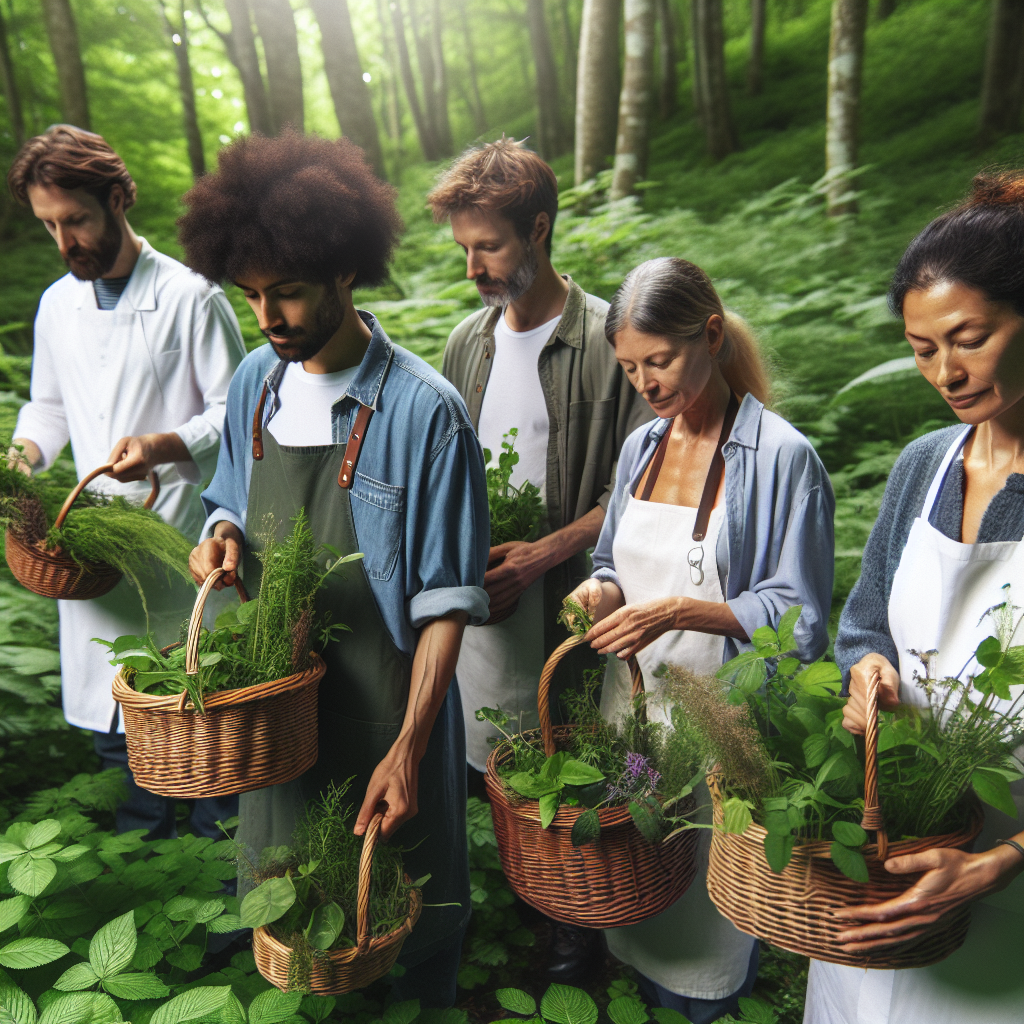In the Face of Crisis, These Herbalists Say the Future of Food Is Wild
Inspired by the VegNews.com feature, with insights for those with food sensitivities and dietary preferences
Published:
Introduction: Why Wild Foods Are Gaining Attention
As global food systems face unprecedented challenges—climate change, supply chain disruptions, and rising food allergies—herbalists and foraging experts are turning to nature’s pantry for answers. According to a recent VegNews.com article, the future of food may be less about supermarkets and more about the wild plants growing in our backyards and local parks.
For people with food sensitivities, allergies, or specialized dietary preferences, wild foods offer a promising, nutrient-rich, and often hypoallergenic alternative. This article explores why herbalists are championing wild foods, how recent research supports their claims, and how modern technology—like Food Scan Genius and Yuka—can help you safely embrace this ancient yet innovative way of eating.
The Crisis: Modern Food Systems Under Pressure
The last few years have exposed the vulnerabilities of our global food system. From pandemic-induced shortages to extreme weather affecting crops, the need for resilient, local, and diverse food sources has never been clearer. According to the 2023 FAO State of Food Security and Nutrition in the World Report, over 2.4 billion people faced moderate or severe food insecurity in 2023—a number expected to rise with ongoing crises.
Meanwhile, food allergies and sensitivities are on the rise. The CDC reports that food allergies among children increased by 50% between 1997 and 2011, with adult allergies also climbing. For many, finding safe, nutritious, and affordable food is a daily challenge.
Herbalists’ Solution: Foraging and Wild Foods
In the VegNews.com article, leading herbalists like Asia Suler and Sam Thayer argue that wild foods are not just a nostalgic nod to the past—they’re a practical, sustainable solution for the future. Wild plants like dandelion, nettle, purslane, and lamb’s quarters are abundant, nutrient-dense, and often overlooked by modern eaters.
“Wild foods are resilient,” says Suler. “They thrive without pesticides, fertilizers, or irrigation. They’re adapted to local climates and conditions, making them a reliable food source even when cultivated crops fail.”
Foraging is also deeply inclusive: many wild foods are naturally gluten-free, dairy-free, and free of common allergens, making them accessible to people with a wide range of dietary needs.
Wild Foods and Food Sensitivities: What Recent Research Says
Recent research underscores the benefits of wild foods for people with food sensitivities and special diets. A 2024 study published in Scientific Reports found that wild edible plants often have higher micronutrient and antioxidant levels than their cultivated counterparts, with lower rates of allergenic proteins.
Another 2023 review in Frontiers in Nutrition highlighted that foraged foods can diversify the diet, supporting gut health and reducing reliance on processed foods—which are often the culprits behind food sensitivities and intolerances.
- Gluten-Free Options: Many wild greens and roots are naturally gluten-free.
- Dairy-Free Nutrition: Wild nuts and seeds offer plant-based calcium, magnesium, and healthy fats.
- Low Allergenicity: Wild foods have not been bred for mass production, so they’re less likely to contain the proteins that trigger common allergies.
How to Start Foraging: Safety, Ethics, and Accessibility
Foraging isn’t just for experts. With the right knowledge and tools, anyone can start supplementing their diet with wild foods. Here are key steps to begin safely:
- Learn from Experts: Join local foraging walks or workshops led by experienced herbalists.
- Use Reliable Guides: Invest in region-specific field guides or use reputable apps for plant identification.
- Start Small: Begin with easily identifiable plants like dandelion, chickweed, or wild garlic.
- Harvest Responsibly: Only take what you need, and avoid endangered or protected species.
- Check Local Laws: Some areas restrict foraging in parks or public lands.
For those with food sensitivities, always try a small amount of a new wild food first, and consult with your healthcare provider if you have concerns.
Modern Tools: Food Scan Genius and Yuka for Safe Wild Eating
Technology is making wild food consumption safer and more accessible. Apps like Food Scan Genius and Yuka are revolutionizing the way people with food sensitivities and dietary preferences approach new foods.
- Food Scan Genius: This app allows users to scan barcodes or search for foods, including some wild food products, to check for allergens, additives, and nutritional content. For foragers, it can cross-reference wild food products with known allergen databases, helping users avoid risky ingredients.
- Yuka: Yuka provides detailed ingredient analysis and health scores for packaged foods, including some wild food brands. While it doesn’t identify wild plants in nature, it helps consumers make informed choices about wild food products available in stores or online.
As wild foods become more mainstream, expect these apps to expand their databases, making it easier for everyone—especially those with allergies or sensitivities—to enjoy wild nutrition safely.
Wild Foods for Every Dietary Preference
Whether you’re vegan, gluten-free, paleo, or simply seeking to diversify your diet, wild foods offer something for everyone:
- Vegans: Wild greens, nuts, and seeds provide plant-based protein, iron, and omega-3s.
- Gluten-Free Diets: Roots like wild carrot and tubers like Jerusalem artichoke are naturally gluten-free.
- Paleo and Whole Foods: Wild foods fit perfectly into ancestral diets, offering unprocessed, nutrient-dense options.
- Low-FODMAP: Many wild greens are low in fermentable carbohydrates, suitable for sensitive guts.
In the words of herbalist Sam Thayer, “Wild foods are the original superfoods. They’re what our bodies evolved to eat.”
Environmental and Social Benefits of Wild Foods
Beyond personal health, wild foods offer significant environmental and social advantages:
- Low Carbon Footprint: No need for transportation, packaging, or refrigeration.
- Biodiversity: Foraging encourages the preservation of wild habitats and plant species.
- Food Sovereignty: Wild foods empower communities to rely less on industrial agriculture.
- Resilience: Wild plants are adapted to local conditions, making them more resilient to climate change.
These benefits align with the UN Sustainable Development Goals for sustainable consumption and production.
Addressing Concerns: Safety, Allergies, and Misconceptions
While wild foods are generally safe, there are risks if you misidentify plants or consume them in large quantities. Here’s how to mitigate common concerns:
- Allergies: Although wild foods are less likely to cause allergies, always test new foods in small amounts.
- Toxic Lookalikes: Use multiple sources for plant identification. When in doubt, don’t eat it.
- Pollution: Forage away from roadsides, industrial sites, and areas treated with chemicals.
- Digestibility: Some wild foods are best cooked or prepared in specific ways to reduce natural toxins.
Modern apps and local foraging groups can help you identify safe foods and avoid common pitfalls.
How to Incorporate Wild Foods Into Your Diet
Getting started with wild foods is easier than you might think. Here are some practical ways to add them to your meals:
- Salads: Add young dandelion or chickweed leaves for a nutrient boost.
- Soups and Stews: Nettle and wild garlic add flavor and minerals.
- Pesto: Blend wild greens with nuts, olive oil, and garlic for a wild twist on classic pesto.
- Teas: Brew wild herbs like mint, yarrow, or elderflower for soothing drinks.
- Snacks: Try roasted wild seeds or nuts for a healthy snack.
For those with food sensitivities, always introduce new wild foods one at a time and monitor your body’s response.
Wild Food Recipes for Sensitive Diets
Here are two easy, allergy-friendly wild food recipes to try:
Wild Greens Pesto (Vegan & Gluten-Free)
- 2 cups wild greens (dandelion, chickweed, or nettle)
- 1/2 cup sunflower seeds
- 1/4 cup olive oil
- 1 clove garlic
- Salt and lemon juice to taste
Blend all ingredients until smooth. Serve with gluten-free pasta or as a dip.
Nettle Soup (Dairy-Free, Nut-Free)
- 4 cups fresh nettle leaves (use gloves to handle)
- 1 onion, chopped
- 2 potatoes, diced
- 4 cups vegetable broth
- Salt and pepper to taste
Sauté onion, add potatoes and broth, bring to a boil. Add nettles, simmer 10 minutes, blend until smooth.
The Future: What’s Next for Wild Foods?
As more people discover the benefits of wild foods, expect to see them featured in restaurants, farmers’ markets, and even packaged goods. According to Mintel’s 2024 Food Trends Report, wild and foraged ingredients are among the top trends for 2025, driven by consumer demand for sustainability, nutrition, and authenticity.
The integration of technology, such as AI-powered identification apps and allergen databases





